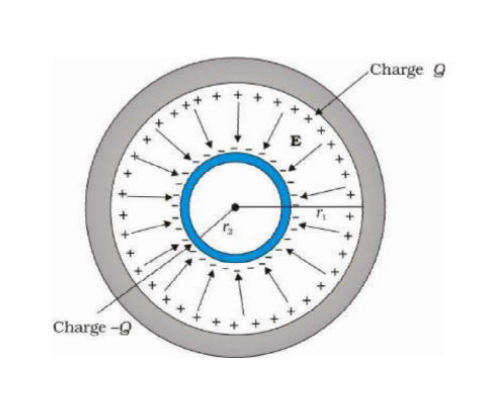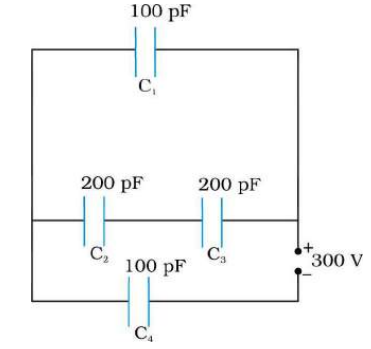EXERCISE from PSEB Chapter 8 ELECTROSTATIC POTENTIAL AND CAPACITANCE for Class 12
| Class 12 | PHYSICS |
| Chapter | ELECTROSTATIC POTENTIAL AND CAPACITANCE |
| PSEB | EXERCISE |
| Medium | English |
| Academic Year | 2023-2024 |
Question 13
In a parallel plate capacitor with air between the plates, each plate has an area of 6×10−3m2 and the distance between the plates is 3 mm. Calculate the capacitance of the capacitor. If this capacitor is connected to a 100 V supply, what is the charge on each plate of the capacitor?View SolutionQuestion 14
A parallel plate capacitor a air between its plates having plate area of 6*10^-3 m^2 and separation between them 3 mm is connected to a 100 V battery. Explain what would happen when a 3 mm thick mica sheet (of dielectric constant = 6) were inserted between the plates, while the voltage supply remained connected.View SolutionQuestion 15
A parallel plate capacitor a air between its plates having plate area of 6*10^-3 m^2 and separation between them 3 mm is connected to a 100 V battery. Explain what would happen when a 3 mm thick mica sheet (of dielectric constant = 6) were inserted between the plates, after the supply was disconnected.View SolutionQuestion 23
Show that the normal component of electrostatic field has a discontinuity from one side of a charged surface to another given by (E2−E1)ˆn=σε0 where ˆn is a unit vector normal to the surface at a point and is the surface charge density at that point. (The direction ofˆn is from side 1 to side 2.) Hence show that just outside a conductor, the electric field isσˆn/ε0View SolutionQuestion 24
Show that the normal component of electrostatic field has a discontinuity from one side of a charged surface to another given by (E2−E1)ˆn=σε0 where n is a unit vector normal to the surface at a point and is the surface charge density at that point. (The direction of ˆn is from side 1 to side 2.) Hence show that just outside a conductor, the electric field is σˆn/ε0 . Show that the tangential component of electrostatic field is continuous from one side of a charged surface to another. View SolutionQuestion 26
In a hydrogen atom, the electron and proton are bound at a distance of about 0.53 A. (a) Estimate the potential energy of the system in eV, taking the zero of the potential energy at infinite separation of the electron from proton. (b) What is the minimum work required to free the electron, given that its kinetic energy in the orbit is half the magnitude of potential energy obtained in (a)? View SolutionQuestion 27
In a hydrogen atom, the electron and proton are bound at a distance of about 0.53 A: (a) Estimate the potential energy of the system in eV, if the zero of potential energy is taken at 1.06∘A separation of the electron from proton? (b) What is the minimum work required to free the electron, given that its kinetic energy in the orbit is half the magnitude of potential energy obtained in (a)? View SolutionQuestion 28
If one of the two electrons of a H2 molecule is removed, we get a hydrogen molecular ion H+2 . In the ground state of an H+2 , the two protons are separated by roughly 1.5∘A. and the electron is roughly 1 A from each proton. Determine the potential energy of the system. Specify your choice of the zero of potential energy.View SolutionQuestion 29
Two charged conducting spheres of radii a and b are connected to each other by a wire. What is the ratio of electric fields at the surfaces of the two spheres? Use the result obtained to explain why charge density on the sharp and pointed ends of a conductor is higher than on its flatter portions.View SolutionQuestion 31
Two charges -q and +q are located at points (0, 0, -a) and (0, 0, a), respectively. How much work is done in moving a small test charge from the point (5,0,0) to (-7,0,0) along the x-axis? Does the answer change if the path of the test charge between the same points is not along the x-axis?View SolutionQuestion 32
Figure 2.34 shows a charge array known as an electric quadrupole. For a point on the axis of the quadrupole, obtain the dependence of potential on r for r/a » 1, and contrast your results with that due to an electric dipole, and an electric monopole (i.e., a single charge). : View Solution
View SolutionQuestion 33
An electrical technician requires a capacitance of 2μF in a circuit across a potential difference of 1 kV. A large number of 1μF capacitors are available to him each of which can withstand a potential difference of not more than 400 V. Suggest a possible arrangement that requires the minimum number of capacitors.View SolutionQuestion 34
What is the area of the plates of a 2 F parallel plate capacitor, given that the separation between the plates is 0.5 cm? [You will realise from your answer why ordinary capacitors are in the range of μF or less. However, electrolytic capacitors do have a much larger capacitance (0.1 F) because of very minute separation between the conductors.)View SolutionQuestion 37
The plates of a parallel plate capacitor have an area of 90cm2 each and are separated by 2.5 mm. The capacitor is charged by connecting it to a 400 V supply. (a) How much electrostatic energy is stored by the capacitor? (b) View this energy as stored in the electrostatic field between the plates, and obtain the energy per unit volume u. Hence arrive at a relation between u and the magnitude of electric field E between the plates.View SolutionQuestion 40
A spherical capacitor consists of two concentric spherical conductors, held in position by suitable insulating supports (Fig. 2.36). Show that the capacitance of a spherical capacitor is given by C=4πε0r1r2(r1)−(r2) where r1 and r2 are the radii of outer and inner spheres, respectively.: View Solution
View SolutionQuestion 41
A spherical capacitor has an inner sphere of radius 12 cm and an outer sphere of radius 13 cm. The outer sphere is earthed and the inner sphere is given a charge of 2.5μC. The space between the concentric spheres is filled with a liquid of dielectric constant 32. Determine the capacitance of the capacitor.View SolutionQuestion 42
A spherical capacitor has an inner sphere of radius 12 cm and an outer sphere of radius 13 cm. The outer sphere is earthed and the inner sphere is given a charge of 2.5μC. The space between the concentric spheres is filled with a liquid of dielectric constant 32. What is the potential of the inner sphere?View SolutionQuestion 43
A spherical capacitor has an inner sphere of radius 12 cm and an outer sphere of radius 13 cm. The outer sphere is earthed and the inner sphere is given a charge of 2.5μC. The space between the concentric spheres is filled with a liquid of dielectric constant 32. Compare the capacitance of this capacitor with that of an isolated sphere of radius 12 cm. Explain why the latter is much smaller.View SolutionQuestion 51
A cylindrical capacitor has two co-axial cylinders of length 15 cm and radii 1.5 cm and 1.4 cm. The outer cylinder is earthed and the inner cylinder is given a charge of 3.5μC. Determine the capacitance of the system and the potential of the inner cylinder. Neglect end effects (i.e., bending of field lines at the ends).View SolutionQuestion 52
A parallel plate capacitor is to be designed with a voltage rating 1 kV, using a material of dielectric constant 3 and dielectric strength about 107Vm−1. (Dielectric strength is the maximum electric field a material can tolerate without breakdown, i.e., without starting to conduct electricity through partial ionisation.) For safety, we should like the field never to exceed, say 10% of the dielectric strength. What minimum area of the plates is required to have a capacitance of 50 pF?View SolutionQuestion 57
In a Van de Graaff type generator a spherical metal shell is to be a 15×106V electrode. The dielectric strength of the gas surrounding the electrode is 5×107Vm−1. What is the minimum radius of the spherical shell required? (You will learn from this exercise why one cannot build an electrostatic generator using a very small shell which requires a small charge to acquire a high potential.)View SolutionQuestion 59
Answer the following: The top of the atmosphere is at about 400 kV with respect to the surface of the earth, corresponding to an electric field that decreases with altitude. Near the surface of the earth, the field is about 100Vm−1. Why then do we not get an electric shock as we step out of our house into the open? (Assume the house to be a steel cage so there is no field inside!)View SolutionQuestion 61
Answer the following: The discharging current in the atmosphere due to the small conductivity of air is known to be 1800 A on an average over the globe. Why then does the atmosphere not discharge itself completely in due course and become electrically neutral? In other words, what keeps the atmosphere charged?View Solution
